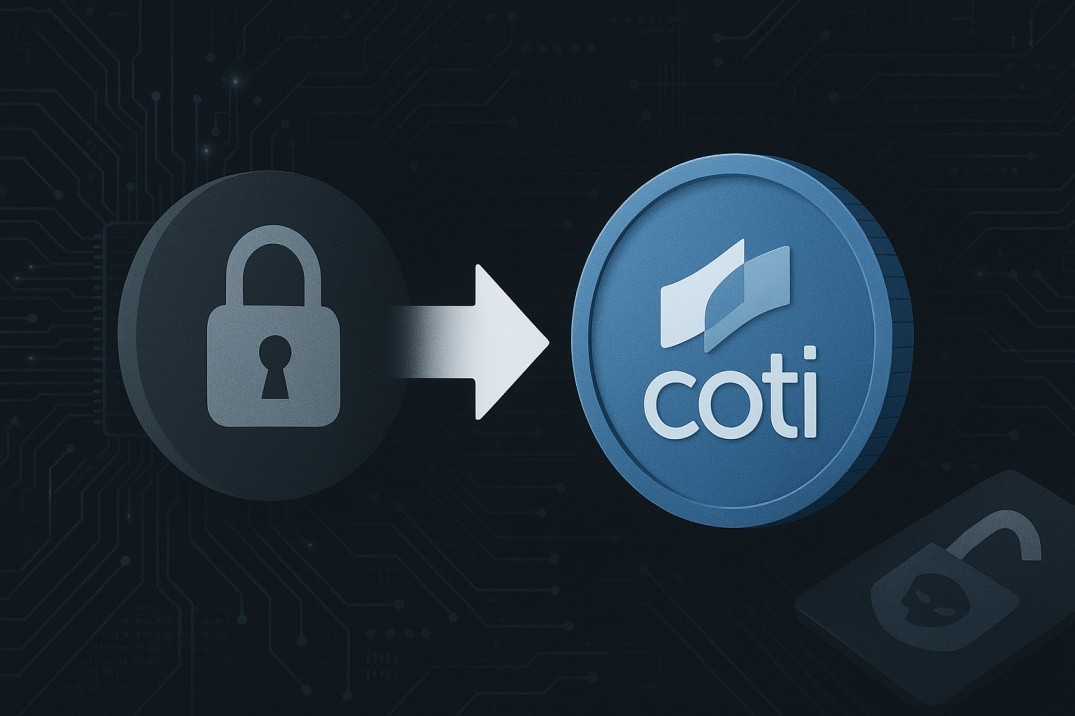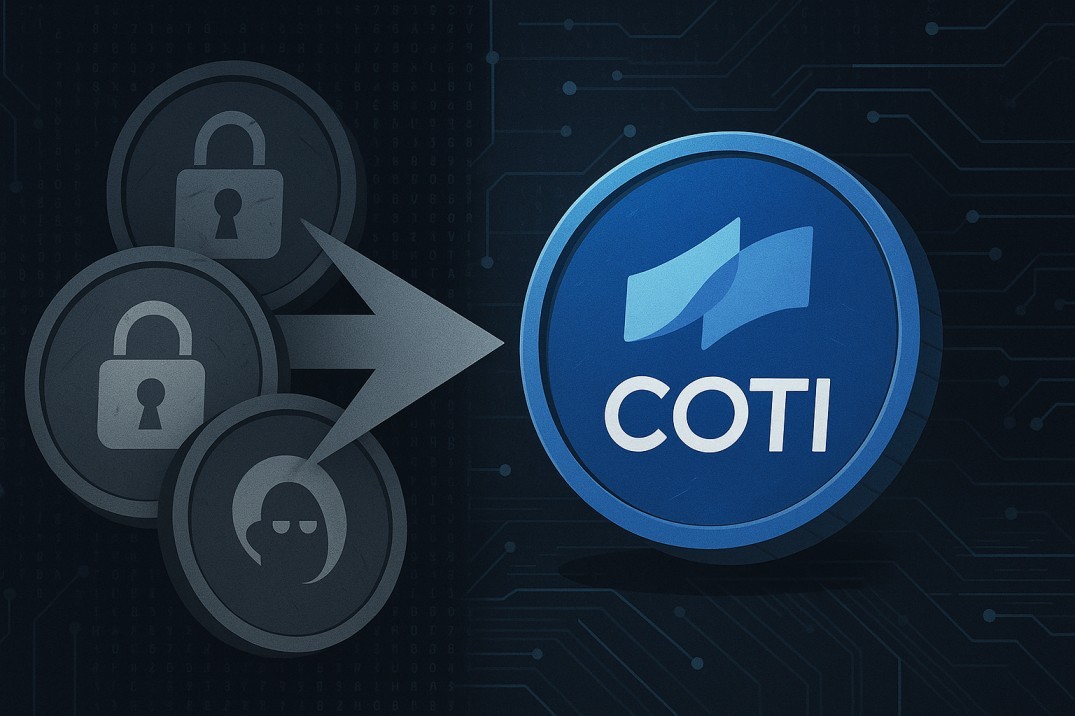TL;DR
- The traditional privacy-coin model (e.g., Monero or Zcash) emphasises anonymity by default, which has led to regulatory, listing and adoption challenges.
- COTI takes a different path: not mere anonymity, but confidentiality + auditability + regulation alignment, using garbled circuits and selective disclosure.
- COTI’s privacy layer is EVM-compatible, meaning developers can deploy encrypted smart contracts using familiar Ethereum tools. Privacy is now usable, scalable, and interoperable.
- Performance is a key differentiator. COTI’s benchmark study shows its Garbled Circuits are between 1,800 and 3,000 times faster than leading FHE solutions, processing private operations in microseconds instead of seconds.
- Selective disclosure is COTI’s defining principle: users can choose what to reveal and to whom, offering privacy with accountability, a balance that privacy coins never achieved.
- COTI isn’t trying to be another Monero or Zcash. It’s creating a bridge between the anonymity of privacy coins and the transparency demanded by global regulation, making privacy sustainable, not outlawed.
As privacy becomes a baseline requirement rather than a niche feature, COTI's architecture positions it as the infrastructure layer replacing privacy coins-not simply competing with them. Privacy coins have long held a special place in crypto lore: the idea of "shielded transactions," "anonymous transfers," coins that shield you from prying eyes. They promised financial confidentiality, fungibility and control. Yet over time, many have hit regulatory headwinds, listing issues, and technical limitations.
Enter COTI. With its privacy-first architecture rooted in garbled circuits, COTI isn't asking to be another privacy coin-it's proposing to be the next generation privacy layer that privacy coins aimed to be but couldn't fully execute, especially under regulatory pressure.
This article unpacks why the shift matters, how COTI differs, and why this may mark a turning point in how crypto handles privacy.
The Privacy Coin Legacy: Strengths & Weaknesses
Monero: Privacy by Default
Monero remains one of the most well-known privacy coins. It uses ring signatures, stealth addresses and RingCT to hide senders, recipients and amounts. In doing so, it achieves strong anonymity and fungibility. But that very strength has become a challenge. Regulators have called out "anonymity-enhanced cryptocurrencies" (AECs) for limiting transaction traceability. Exchanges have delisted or flagged Monero. Mining and network-control concerns (e.g., claims of mining-pool dominance) have also emerged.
Zcash: Optional Privacy, Structural Constraints
Zcash offers shielded and transparent modes. Users can choose privacy-enabled transactions via zk-SNARKs, or transparent flows. But in practice, most users default to transparent addresses for usability or cost. Studies show shielded pool usage is low, making analytics easier for adversaries. Zcash's dual nature dilutes its privacy promise.
What's the Common Problem?
- Regulatory friction: Full anonymity = red flag for exchanges, regulators, institutional users.
- Usability and liquidity: Privacy often comes at higher cost or lower liquidity or risk of delisting.
- Technical trade-offs: Many privacy coin models sacrifice scalability or interoperability.
- Migration risk: As Web3 evolves, integration with regulated finance and institutions becomes more critical. Pure anonymity can become a liability.
Why COTI Doesn't Just Compete-It Aims to Replace

Privacy Designed for Scale & Compliance
Unlike the "privacy-at-all-costs" model, COTI's architecture emphasises confidentiality with accountability. With garbled circuits, it allows encrypted inputs, encrypted state, yet verifiable outputs. It enables "privacy on demand," not blanket anonymity.
From COTI's documentation:
This performance means privacy isn't just theoretically strong-it can work in real-world, high-throughput settings.
Selective Disclosure & "Audit-Friendly" Privacy
The quote from CEO Shahaf Bar-Geffen is telling:
This means users, institutions or regulators can reveal or audit when required-while the rest remains private. It's a middle ground between full anonymity and full transparency.
Interoperability & EVM Compatibility
COTI is built to work with standard Ethereum-tooling and EVM-compatible smart contracts. This makes it easier for applications to migrate or integrate privacy layers rather than rebuild from scratch-a major barrier many privacy coins faced.
Institutional & Regulatory Readiness
Privacy coins often struggled to gain institutional adoption due to lack of disclosure or audit pathways. COTI's model is explicitly designed with institutions, central banks, and regulated environments in mind. That positions it differently: not just a crypto tool, but part of enterprise/financial infrastructure.
How This Replacement Narrative Matters for Developers & Users
For Developers
If you're building dApps, token logic, DeFi protocols or real-world asset platforms, you need privacy that works at scale, complies with audit/reg requirements, and doesn't impose huge performance overhead. Building on a chain designed for anonymity only may create future rewrite risk. COTI offers a privacy foundation that looks future-proof.
For Users
Users increasingly expect confidentiality-not necessarily total anonymity-but significant protection and control over data. Meanwhile, they also want apps that work, are liquid, integrate into broader ecosystems. A network that gives privacy but also access and compatibility has an edge.
For the Crypto Ecosystem
As regulation tightens, privacy coins face more pressure. Delistings, compliance cost, regulatory risk. A privacy-infrastructure that blends confidentiality with auditability offers a path forward for the ecosystem to maintain privacy without being marginalized. COTI may serve as the "replacement" layer through which applications seeking privacy and adoption route themselves.
COTI vs Privacy Coins: Key Dimensions of Difference

When you line COTI up against privacy coins like Monero and Zcash, the contrast becomes sharp almost immediately. Privacy coins were designed for anonymity first, everything else second. COTI was designed for confidentiality, scalability, and compliance-all at once.
Monero hides everything by default. Every transaction, sender, and receiver is concealed using ring signatures and stealth addresses. That makes it incredibly private, but it also makes it nearly impossible for exchanges or institutions to integrate without running into compliance hurdles. Zcash, on the other hand, took a hybrid approach-offering both transparent and shielded transactions. It gave users flexibility, but in practice, that flexibility backfired. Most users stuck with the transparent mode for convenience, leaving only a small percentage of transactions truly private.
COTI flips that equation. Instead of forcing full anonymity or optional privacy, it introduces what its team calls selective disclosure. That means you can decide what to reveal and to whom, making it possible for users to stay private while still allowing for audit or compliance when needed. This concept alone puts it in a different category-it's not anonymity for its own sake, but privacy designed for real-world systems.
Performance is another major divider. The cryptographic tools behind Monero and Zcash-ring signatures and zk-SNARKs-offer strong privacy but at a cost: slower processing and heavy computational requirements. COTI's garbled circuits are built differently. They're engineered to process private data thousands of times faster than existing privacy tech, cutting execution times down to microseconds instead of seconds. That level of performance makes privacy usable, not just theoretical. Then there's integration. Monero and Zcash often live in isolated ecosystems, with limited interoperability and liquidity. COTI, by contrast, is EVM-compatible. Developers can build and deploy encrypted smart contracts using familiar Ethereum tools-meaning privacy doesn't come at the expense of usability.
Finally, there's the question of perception. Privacy coins are often viewed as a compliance risk, which has led to delistings and restrictions on major exchanges. COTI's framework is intentionally designed to work with regulators, banks, and enterprises, not against them. It's privacy that fits into the modern financial world rather than standing outside of it.
In short, Monero and Zcash were built for an era where privacy meant hiding. COTI is built for an era where privacy means control-over what you share, when, and why. It's not competing with those older systems. It's quietly building the infrastructure meant to replace them.
Why the Shift From "Privacy Coin" to "Privacy Infrastructure" Isn't Just Semantic
Privacy Coins Were a First Phase
In the early phase of crypto, privacy coins answered an ideologically strong demand: absolute anonymity, financial freedom, fungibility. They played an important role. But as the ecosystem matured, the needs expanded: regulated finance, institutional capital, DeFi interoperability, real-world asset tokenisation.
Infrastructure Needs Scale, Regulation & Compliance
Today, privacy isn't just a niche feature-it's necessary for applications handling identity, finance, enterprise flows, cross-border payments, tokenised assets, or any regulated partner. That means privacy must co-exist with compliance, performance and ecosystem access. Many privacy coins weren't built for that tri-merge.
COTI Steps Into That Role
COTI doesn't pitch anonymity-only. It pitches confident confidentiality, where privacy is default but disclosure pathways exist, where performance is viable, where institutions can engage. It thus becomes the infrastructure layer for privacy-first applications, not a standalone anonymous coin.
Risks & What to Watch
Ecosystem Maturity
While the architecture sounds strong, adoption matters. Whether dApps, institutions and regulators will build on COTI remains to be seen. Privacy infrastructure is only useful if applications deploy and users engage.
User Perception & Market Sentiment
Privacy remains a marketing line; coins tied to privacy often suffer if regulation bites. COTI must differentiate clearly so it is not perceived just as "another privacy coin" (which could carry the baggage of delisting risks).
Technical Complexity
Garbled circuits and confidential computation are complex. Developers must adopt new patterns, smart-contract design may change, audit tools evolve. Execution must be smooth.
Competitive Landscape
Other projects are also working privacy infrastructure: ZK firms, MPC, FHE networks. Though COTI claims advantages in performance, the race isn't over. The "privacy infrastructure" narrative is broader than a single chain.
Final Thought
Privacy coins served a vital chapter in crypto's story-highlighting the importance of financial confidentiality and user control. But the story is evolving. As Web3 moves into real-world utility, enterprise adoption, regulated finance and tokenised assets, the requirements for privacy change: they must scale, comply, integrate, perform.
COTI doesn't just aim to compete with privacy coins. It aims to replace them in the sense of becoming the go-to infrastructure layer for applications needing privacy-by-design and regulation-by-default. The architecture, the performance numbers, the institutional fit all suggest that the next wave isn't about anonymous token transfers-but about confidential computation at Web3-scale.
If your mind still sees privacy coins as the future of confidential crypto, perhaps the future is not coins-it's layers. And in that layer game, COTI appears ready to lead.











